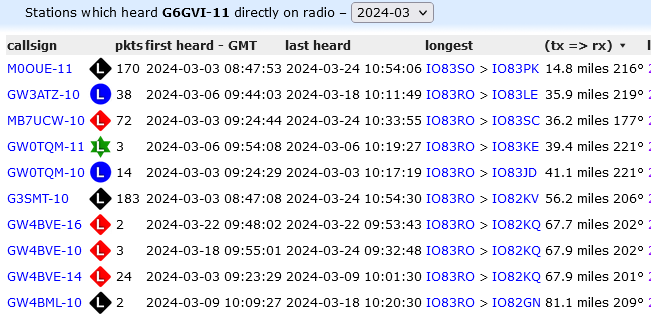Continuing the discussion from LoRa APRS Tracker (Part 1) - #100 by 2E0CPX.
Previous discussions:
Continuing the discussion from LoRa APRS Tracker (Part 1) - #100 by 2E0CPX.
Previous discussions:
I’m definitely thinking about going down the 439 MHz LoRA route, just need to speak to a few people so I get the right gear
I just received my one from the Highlands DMR group. Very nice 3d printed case. The igate is tiny. The tracker takes an 18650 cell. It arrived programmed and resdy to go.
I did see this, the only one that mentions you can choose the frequency within a band Adafruit LoRa Radio Bonnet RFM96W @ 433MHz [RadioFruit] : ID 4075 : Adafruit Industries, Unique & fun DIY electronics and kits
A couple of stations have popped up within 10 miles of me on 439 so I may contact them to see what they are using
I’ve not been out for a while, so as today was the nicest it’s been for weeks, I decided to activate G/SP-008 and G/SP-011 with this contraption strapoed to the back of my rucksack. For the eagle eyed amongst you, you’ll observer it’s a Lilygo TT-Beam hanging precariously from a cheapo 70cm collinear - that I picked up from AliExpress. I wasn’t expecting much from a antenna that cost £14.99 including delivery. However, to my surprise when I hooked it up to VNA, the SWR at 439MHz was a pretty acceptable :1.3:1.
As there’s not a lot of LoRA APRS igates and digirepraters in the South Pennies, I wasn’t expecting much tracking to be happening to be honest. i was hoping my iGate and digireprater (MB7UWS) would have a good crack at it. I was sadly disappointed on this one, however to my surprise, look how far it was picked up - by G3SMT-10 near Oswestry on the Welsh Borders.
That is some distance considering the TX power is only 20 dBm, plus whatever gain the collinear adds
Regards
Dave
Don’t forget the processing gain from it being a spread signal. It’s still impressive though.
That TBeam does look very precarious Dave.
I just adapted the little plastic box in which it was supplied:
You don’t need that big colinear - I’ve just been using a quarter-wave, and then the whole unit is small an light enough to tie onto my shoulder-strap, so the antenna is in the clear.
With this, I get excellent coverage from the southern slopes of Winter Hill:

and Peter G3SMT even picks up the tracker while it’s still in the boot of my car!
Yes it did take a bit of a battering Ross; but is still going strong. I’ll definitely put it in a case next time!
Dave
What exactly is the difference between LoRA 32 and LoRA Meshtastic? I’m assuming you need LoRA 32 on 439 Mhz? Excuse my ignorance but it is only the last few days that I have seriously been considering building a LoRA digipeater/iGate
I was having the same thoughts as 2E0CPX and was wondering is there a shopping list of parts to setup an iGate. Pi/dongle/other hardware.
Cheers
john
m0vaz
@ON6ZQ One can get a longer range and higher reliability by compressing the data instead of sending plain ASCII. See: APRS 438 LoRa
LoRa32 v1.6 or v2.1 are almost the same board and this board could be used for LORA APRS and MESHTASTIC and few other firmwares. The same goes for the T-Beam (in all his versions) which is used also for lots of firmwares
Here’s what I’ve been using for my APRS iGates (MB7UWS-10) and DigiRepeaters (MV7UWS-2)
Heltec WiFi LoRa 32(V3) - select the 433MHz version
14.9€ 57% OFF|Heltec wifi lora 32 (v3) dev board mit sx1262 und ESP32 S3FN8 chip oled, meshtastic mesh netzwerk pax counter unterstützung heltec v3| | - AliExpress?
spm=a2g0o.store_pc_promotion.promoteWysiwyg_502385839.1005005443005152
LILYGO® LoRa32 V2.1 ESP32 - select the 433MHz version
Both are supported by Ricardo Guzman’s excellent repos in github:
https://github.com/richonguzman/LoRa_APRS_iGate
Here’s a picture of the Lilygo board (top) and Heltec board (bottom) both running the same APRS iGate software from Richard’s github repos:
For the tracker (M0JKS-7and M0JKS-15), I’ve been using
# LILYGO® T-Beam ESP32
Available here:
I’m currently using Peter Buchegger’s repository:
but plan to test Richard’s in the near future;
Dave
I’m planning on trying my one out this afternoon on Morven if it ever stops snowing. I will also have my FT-3d beaconing MM0EFI-7 on 144.800MHz as a comparison.
14.800Mhz… Maybe 144.800Mhz would be better ![]()
Thanks Dave. Do you need a NOV for a RX only iGate using LoRa ?
Nope
Just checking, wasn’t sure with this being LoRa.
Before the OFCom licensing changes a NOV was not required for an RX iGate - as long as it wasn’t beaconing (i.e. Transmitting unattended). Since the changes, this has all changed and you can use your callsign for an unattended Tx iGate or Digirepeater as long as the power is below some threshold:
in particular, at the top of page 3 it says.
“For most repeaters, beacons and gateways you will no longer require an NoV.1 Licensees
will have to carry out an interference assessment to prove that they have minimised the
risk of interference to other users. For powers above 5W, a call sign must be obtained
from the RSGB”.
I still have a NOV in place for my 144.8MHz APRS TX/TX iGate/Digirepeater (MB7UWS) and 439.9125MHz LoRa APRS iGate and digirepeater. I recently received an update from the RSGB saying that because of the Ofcom licensing changes I can now use 25W on 144.8MHz. Before hand it was 1W I think.
Dave